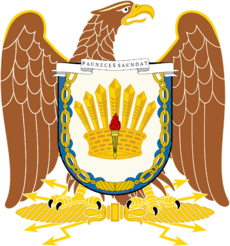Qangreč
Assembly of the Woqalate Qangreč lei Woqalaté | |
|---|---|
| 339th Qangreč Ausata'ala | |
 | |
| Type | |
| Type | Unicameral |
| History | |
| Founded | July 31, 677 |
| Preceded by | Abio Senate |
New session started | May 27, 2035 |
| Leadership | |
Aphío Pelikaanen (PSt) Since October 4, 2035 | |
| Structure | |
 | |
Qangreč political groups |
|
| Elections | |
Qangreč last election | May 17, 2035 |
Qangreč next election | No later than July 2039 |
| Meeting place | |
 | |
The Assembly of the Woqalate (Qabóri: Qangreč lei Woqalaté), simply referred to as the Qangreč, the Qabóri translation for the word "assembly," is the supreme legislative body of the Tierradorian Woqalate. It is a unicameral legislature, and is one of few in the world to hold that status. From 1622 to 1971, the Qangreč was bicameral, featuring the Naswadet as the upper house and the Šawardet as the lower. During the height of the Walakee State, however, autocrat Pedro Kintón dissolved both houses and reformed the Qangreč as a 438-member unicameral legislature, as it stands today.
Members of the Qangreč are called delegates, and they typically serve a four-year term. Term limits are in place for every delegate along with the Qaphenć, whom are usually limited to three terms. However, the Fourth Term Rule allows delegates to run for a fourth term, with the risk of no longer being allowed to hold any political office if they lose. Delegates are chosen through 438 single-member constituencies, referred to as ridings. Ridings are redrawn every ten years based on the results of the Tierradorian census.
The powers of the Qangreč are outlined in the Woqalate Charter, which employs a system of checks and balances under semi-balanced jurisdiction of the Crown. Since 1772, all legislative meetings were held in the Tavaleset, one of the main components of the Taisgol Teklan. The Qangreč was originally first assembled in 677 AD after the defeat of the Abio Senate and Abio Woqalate in the Abio Wars. From 677 to 1622, the legislature was comprised of 60 independent representatives throughout the Qabóri Woqalate. Following governmental reforms in 1622, the Qangreč was split into two houses with 125 delegates in the Naswadet and 260 delegates in the Šawardet.
Overview
Since 1971, the Qangreč had been a single-branch legislature which consisted of 438 total seats. The Qangreč is elected through a popular vote, with forms of election varying by the respective commonwealth where the election is being held. 12 commonwealths currently use two-round runoff; Auqali, Porvaos, Telohakee, and Teschego use Instant-runoff voting; and Qaleqa and the Saukhin Islands use Party-list proportional representation voting. The 438 seats in the Qangreč are decided by the various constituencies drawn throughout the country, of which they are equally represented by one delegate.
Elections for the Qangreč subsequently become elections for the Qaphenć, as the majority coalition/party's leader is appointed as the Qaphenć by the Woqali. They usually begin with the dissulution of the Qangreč, a power typically held by the Woqali. Tierradorian citizens whom are at least 18 years of age are given the inalienable right to vote in these elections. Until 1971, the two branches of the Qangreč were elected in different ways; by the governors of the commonwealths in the Naswadet, and by popular vote in the Šawardet.